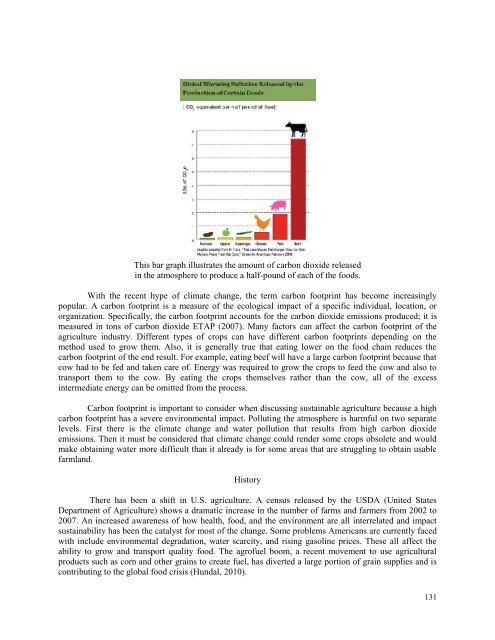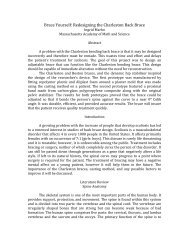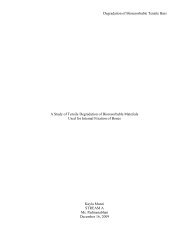Got Food? - the Scientia Review
Got Food? - the Scientia Review
Got Food? - the Scientia Review
Create successful ePaper yourself
Turn your PDF publications into a flip-book with our unique Google optimized e-Paper software.
This bar graph illustrates <strong>the</strong> amount of carbon dioxide released<br />
in <strong>the</strong> atmosphere to produce a half-pound of each of <strong>the</strong> foods.<br />
With <strong>the</strong> recent hype of climate change, <strong>the</strong> term carbon footprint has become increasingly<br />
popular. A carbon footprint is a measure of <strong>the</strong> ecological impact of a specific individual, location, or<br />
organization. Specifically, <strong>the</strong> carbon footprint accounts for <strong>the</strong> carbon dioxide emissions produced; it is<br />
measured in tons of carbon dioxide ETAP (2007). Many factors can affect <strong>the</strong> carbon footprint of <strong>the</strong><br />
agriculture industry. Different types of crops can have different carbon footprints depending on <strong>the</strong><br />
method used to grow <strong>the</strong>m. Also, it is generally true that eating lower on <strong>the</strong> food chain reduces <strong>the</strong><br />
carbon footprint of <strong>the</strong> end result. For example, eating beef will have a large carbon footprint because that<br />
cow had to be fed and taken care of. Energy was required to grow <strong>the</strong> crops to feed <strong>the</strong> cow and also to<br />
transport <strong>the</strong>m to <strong>the</strong> cow. By eating <strong>the</strong> crops <strong>the</strong>mselves ra<strong>the</strong>r than <strong>the</strong> cow, all of <strong>the</strong> excess<br />
intermediate energy can be omitted from <strong>the</strong> process.<br />
Carbon footprint is important to consider when discussing sustainable agriculture because a high<br />
carbon footprint has a severe environmental impact. Polluting <strong>the</strong> atmosphere is harmful on two separate<br />
levels. First <strong>the</strong>re is <strong>the</strong> climate change and water pollution that results from high carbon dioxide<br />
emissions. Then it must be considered that climate change could render some crops obsolete and would<br />
make obtaining water more difficult than it already is for some areas that are struggling to obtain usable<br />
farmland.<br />
History<br />
There has been a shift in U.S. agriculture. A census released by <strong>the</strong> USDA (United States<br />
Department of Agriculture) shows a dramatic increase in <strong>the</strong> number of farms and farmers from 2002 to<br />
2007. An increased awareness of how health, food, and <strong>the</strong> environment are all interrelated and impact<br />
sustainability has been <strong>the</strong> catalyst for most of <strong>the</strong> change. Some problems Americans are currently faced<br />
with include environmental degradation, water scarcity, and rising gasoline prices. These all affect <strong>the</strong><br />
ability to grow and transport quality food. The agrofuel boom, a recent movement to use agricultural<br />
products such as corn and o<strong>the</strong>r grains to create fuel, has diverted a large portion of grain supplies and is<br />
contributing to <strong>the</strong> global food crisis (Hundal, 2010).<br />
131
















